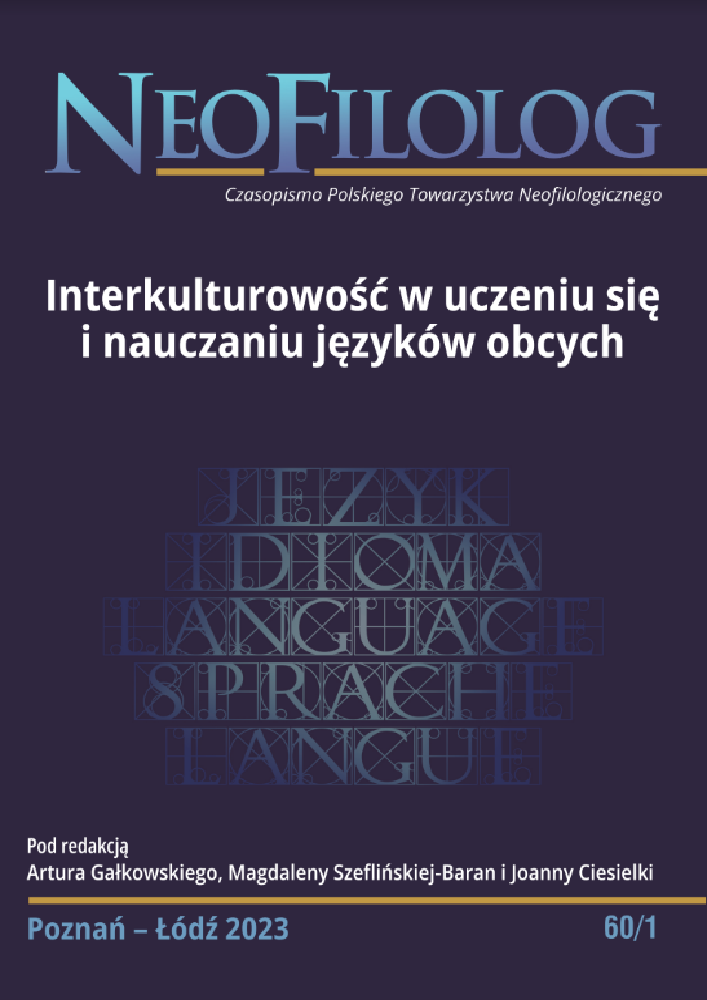Abstract
Meals are commonly known to be a crucial element of life, culture and interpersonal relationships in the Italian Peninsula. In Italian dictionaries of phraseology, idiomatic expressions representing names of culinary items are the vast majority of dictionary items. This is a sign of the importance of meals, also considered as feasting together and the Italian food centrism. As the cultural component is an integral element of language education at an academic level, Italian culinary items as components of idiomatic and fixed expressions in Vatican culinary items related to culturally rooted habits and secular Catholic rituals will be analyzed. The study presented in the paper aims at: 1. clarifying the sociolect specifics of the Vatican’s clergy and kitchen staff members; 2. determining the importance of food in the socio-cultural reality in the Vatican as a type of a culture code and an element of the regional/national culture; 3. emphasizing the essence of semantic and lexical problems related to food in academic intercultural didactics, e.g. a specialization proseminar in linguistics or translation studies or a university instructor’s own thematic seminar on culinary matters in the Italian Peninsula.
Literaturhinweise
Apresjan J. (1980), Semantyka leksykalna. Synonimiczne środki języka. Wrocław–Warszawa–Kraków: Ossolineum.
Artusi P. (2017), Włoska sztuka dobrego gotowania. Warszawa: Muza S.A.
Bańczerowski J., Pogonowski J., Zgółka T. (1982), Wstęp do językoznawstwa. Poznań: Wydawnictwo Naukowe UAM.
Celada E. (2010), Sekrety kuchni Watykanu. Warszawa: Świat Książki.
Chruszczewski P. P., Kudła M. (2016), Etnonimy pokarmosemiczne. Tradycje kulinarne w nazwach grup etnicznych z perspektywy językoznawstwa antropologicznego, (w:) Wach S., Buczek K., Knapik A.R., Chruszczewski P. P. (red.), Język, kultura, komunikacja. Wrocław: PAN, s. 9–22.
Drzymała P. (1993), Fraseologia italiana. Słowniczek frazeologiczny włosko-polski. Poznań: Wydawnictwo Naukowe UAM.
Europejski System Opisu Kształcenia Językowego (2003). Online: https://www.ore.edu.pl/wp-content/uploads/attachments/ESOKJ_Europejski-System-Opisu.pdf [DW 10.01.2023].
Frosini G., Montanari M. (2012), Il sapore di una nazione, (w:) Frosini G., Montanari M. (red.), Il secolo artusiano. Atti del Convegno Firenze-Forlimpopoli 30 marzo - 2 aprile 2011. Firenze: Accademia della Crusca, s. 15-20.
Galisson R. (1987), Accéder à la culture partagée par l`entremise des mots à C.C.P. (Charge Culturelle Partagée). „Études de Linguistique Appliquée”, nr 67, s. 119-140.
Godzich A. (2023), Językowo-kulturowy obraz pożywienia człowieka w języku włoskim - implikacje glottodydaktyczne, (w:) Szczęk J., Pawlikowska-Asendrych E. (red.), Kulinarische Welt in Sprache, Kultur und Literatur, Bd. II. Hamburg: Verlag Dr. Kovac, s. 283-295.
Hall E.T. (1976), Beyond Culture. Nowy Jork: Doubleday.
Lapucci C. (1993), Il dizionario dei modi di dire della lingua italiana. Mediolan: Garzanti.
Meisels W. (2001), Podręczny słownik włosko-polski. Dizionario pratico italiano-polacco. M-Z. Warszawa: Wiedza Powszechna.
Moyer-Nocci K., Rolandi G. (2019), The Eternal Table: A Cultural History of Food in Rome. Lanham (Maryland): Rowman & Littlefield Publishers.
Nagórko A., Łaziński M., Burkhardt H. (2004), Dystynktywny słownik synonimów. Kraków: Universitas.
Peeters B. (2016), APPLIED ETHNOLINGUISTICS is cultural linguistics, but is it CULTURAL LINGUISTICS? „International Journal of Language and Culture”, nr 3/2, s. 137–160. DOI: https://doi.org/10.1075/ijolc.3.2.01pee
Pittàno G. (1992), Frase fatta capo ha. Dizionario dei modi di dire, proverbi e locuzioni. Bolonia: Zanichelli.
Sapir E. (1978), Kultura, język, osobowość. Wybrane eseje. Warszawa: PIW.
Tabakowska E. (1999), Gramatyka i obrazowanie. Kraków: PAN.
Turasiewcz, M., Kieżun, B. (2022), Farina. Kuchnia śródziemnomorska. Kraków: ZNAK.
Wierzbicka A. (1996), Prototypes and invariants, (w:) Wierzbicka A., Semantics. Primes and universals. Oxford i Nowy Jork: Oxford University Press, s. 148-169.
Wierzbicka A. (2019), Słowa klucze. Różne języki – różne kultury. Warszawa: Wydawnictwo Uniwersytetu Warszawskiego. DOI: https://doi.org/10.31338/uw.9788323539193
Wilkoń A. (2000), Typologia odmian współczesnej polszczyzny. Katowice: Wydawnictwo Uniwersytetu Śląskiego.
Lizenz
Copyright (c) 2023 Anna Godzich, Szymon Machowski

Dieses Werk steht unter der Lizenz Creative Commons Namensnennung - Keine Bearbeitungen 4.0 International.
Autoren:
Die Autoren der zur Veröffentlichung in der Zeitschrift Neofilolog angenommenen Texte sind verpflichtet, den Vertrag über die Erteilung einer kostenlosen Lizenz für die Werke mit der Verpflichtung zur Erteilung einer Sublizenz CC auszufüllen, zu unterzeichnen und an die Adresse der Redaktion zurückzusenden.
Gemäß Vertrag erteilen die Autoren auf die in der Zeitschrift Neofilolog veröffentlichten Texte der Adam-Mickiewicz-Universität in Poznań eine nicht exklusive und kostenlose Lizenz und erlauben die Verwendung der Sublizenz Creative Commons Attribution-NoDerivatives 4.0 International (CC BY-ND 4.0).
Die Autoren behalten das Recht zur weiteren freien Verfügung über das Werk.
Benutzer:
Interessierte Onlinebenutzer dürfen die seit 2017 veröffentlichten Werke unter folgenden Bedingungen nutzen:
- Anerkennung der Urheberschaft - die Verpflichtung, zusammen mit dem verbreiteten Werk Informationen über die Urheberschaft, den Titel, die Quelle (Links zum Originalwerk, DOI) und die Lizenz selbst bereitzustellen;
- ohne Schaffung abgeleiteter Werke - das Werk muss in seiner ursprünglichen Form erhalten bleiben, ohne Zustimmung des Autors dürfen keine Studien, beispielsweise Übersetzungen, verbreitet werden.
Die Urheberrechte aller veröffentlichen Texte sind vorbehalten.
Sonstige:
Die Adam-Mickiewicz-Universität in Poznań behält das Recht auf die Zeitschrift als Gesamtheit (Layout, Grafik, Titel, Umschlagsprojekt, Logo usw.).

